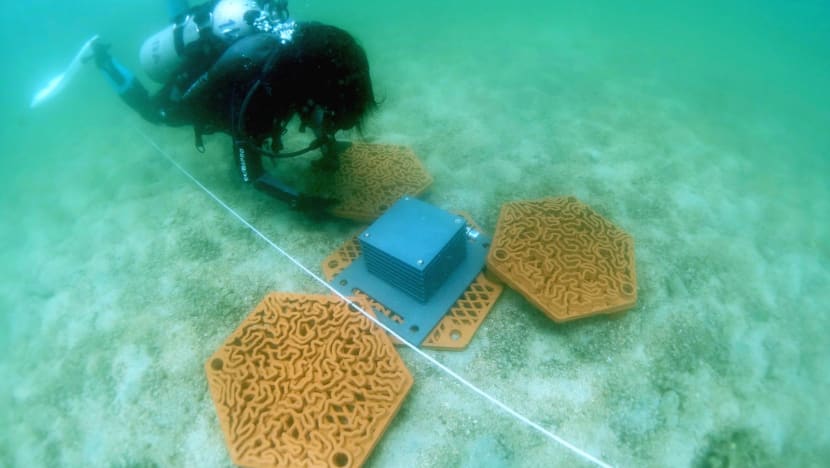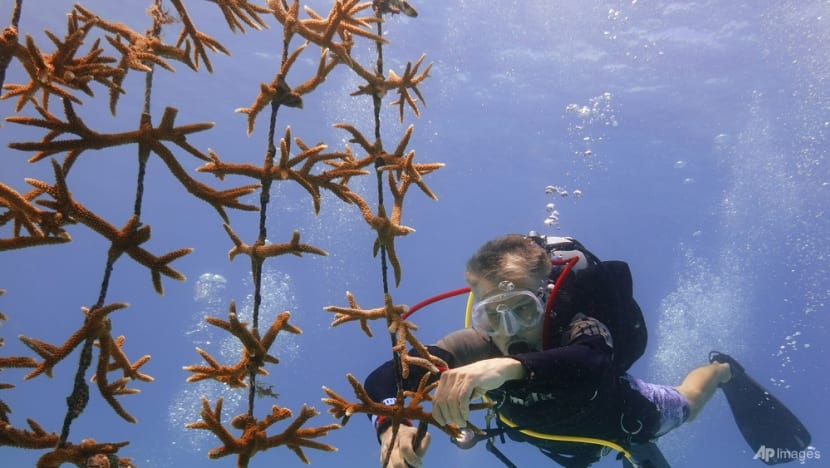Coral kickstart: Reefs get injection of funds at COP28 to stave off extinction
90 per cent of reefs could be gone by 2050. New initiatives formalised at COP28 give a boost to scientists, investors and entrepreneurs trying to reverse the “tragic narrative”.

Archireef's tiles are customised and installed on the seafloor to provide a more hospitable environment for corals. (Photo: Archireef)

This audio is generated by an AI tool.
DUBAI: Off the coast of the United Arab Emirates, in just a small patch of the Arabian Gulf, unusual clay tiles line the seafloor.
An area with heavy maritime traffic, it is also the source of water for vast desalination projects and where ambitious land reclamation is taking place to create new archipelagos for luxury developments.
Yet, it is here that marine biologist-turned-entrepreneur Vriko Yu and coral ecologist David Baker are looking to perform an underwater resuscitation effort.
The duo, who founded Archireef in Hong Kong in 2020, are using 3D-printed terracotta clay tiles to try and restore coral reefs at risk of being wiped out.
The tiles are customised and installed on the seafloor to turn “underwater deserts” into an environment more hospitable for corals.
“Corals need a hard bottom, they need clean water and they need sunlight. These are very simple things that they require. But without a hard bottom substrate, corals can never exist. A coral can't grow on sand,” explained Dr Baker.
“Unfortunately, all over the world we have damaged reefs so much through mining and destructive fishing practices, dredging for coastal development and so forth that the hard bottom is gone.”
Archireef's efforts are a small part of a broader push to inject financial investments and develop technical solutions regionally and globally for coral reefs.
Tourism development, industrial activity, dredging and major bleaching events are among the reasons that native corals in the UAE have struggled.
A 2021 government report found that over 40 per cent of the corals in its territorial waters face regional extinction. Given the lack of available data, the reality could be even worse.
With its tiles installed, Archireef claims a 95 per cent survival rate for baby corals, a vast improvement on many other small-scale reef rehabilitation methods. So far, the start-up has seeded an area of about 500 square metres in both the UAE and Hong Kong.

HALF OF REEFS ALREADY LOST
The demise of coral ecosystems is an unfolding story. Throughout the world, coral reefs are being lost at alarming rates. Half of them have already disappeared and it is estimated that 90 per cent could be gone by 2050 if global temperatures rise by 1.5 degrees Celsius — a best case scenario.
Global carbon emissions continue to push up sea temperatures. Marine heatwaves are becoming increasingly frequent, leading to mass bleaching, events where stressed corals lose their colour, leaving reefs to resemble eerie white bone yards.
“It's a very tragic narrative. If we continue on our current path we lose up to 90 per cent of our coral reefs,” Peter Thomson, the United Nations Secretary-General’s Special Envoy for the Ocean told CNA at the COP28 climate conference.
How can you have a healthy ocean if there isn't any coral in it?"
Yet, a raft of new commitments secured on the sidelines of UN-led climate talks has raised hope that coral reefs have a viable future.
A CORAL BREAKTHROUGH
Finding finance for reef research and protection has been historically difficult. The payback on much of this investment has been “non-existent”, according to Mr Ignace Beguin Billecocq, the UN Climate Change High-Level Champions Ocean Lead.
But at COP28, a network of nations that are home to the majority of the world’s coral reefs have pledged to fast-track action.
Related:
It also aims to accelerate solutions that can impact 30 per cent of degraded reefs by 2030 and stop the drivers of loss, including pollution, destructive coastal development, and overfishing.
The Breakthrough was officially launched by the Global Fund for Coral Reefs (GFCR) at COP28, a blended finance vehicle, and the International Coral Reef Initiative, a global partnership between nations and organisations. GFCR has mobilised an initial US$200 million towards the goals.
“How can we collectively think about changing the system of how coral reefs are funded? So, the vision is to reach by 2030 a tipping point in how the system operates,” Mr Billecocq said during a panel discussion at COP28.
He said it is increasingly important to give clarity to financial institutions, investors and philanthropic organisations on how and why to invest in coral reef businesses.
The Breakthrough also aims to scale up the pipeline of investable projects that can positively impact coral reefs.
“By improving the financing of coral reef-positive businesses, this is where we can attract capital at scale and change the system,” he said.

PRAGMATIC SOLUTIONS NEEDED
The benefits coral reefs provide are vast.
Coral reefs harbour about 25 per cent of ocean biodiversity and provide livelihoods to about one billion people, either directly or indirectly.
Their loss and damage would have major environmental and economic impacts, including in Southeast Asia, home to some of the world’s most precious reef ecosystems.
The Intergovernmental Panel on Climate Change (IPCC) estimated in a major report last year that the degradation of reefs could directly affect the livelihoods of about 4.5 million people in Southeast Asia and the Indian Ocean region alone.
Already, sea temperatures surrounding the coastal areas of the Coral Triangle, a critical ecosystem spanning Indonesia, Malaysia, the Philippines, Papua New Guinea, Timor Leste and Solomon Islands, are rising approximately 0.1 degree Celsius every year and could be 1.4 degrees Celsius warmer by the end of the century.
While the challenge to conserve or restore reefs “might seem impossible”, science and technology could “redefine the boundaries of the possible”, said Carlos Duarte, executive director of the Coral Research & Development Accelerator Platform (CORDAP) launched by the G20 to accelerate coral studies.
Professor Duarte has been involved in marine studies for more than four decades and still believes the ocean’s role in the climate discussion is underestimated and its research under-resourced. He estimates funding for ocean research is only 10 per cent of that for terrestrial studies.
“We have plenty of evidence of how we ignore the oceans in every aspect of life and investments in science, technology and conservation,” he said.
He argued that a boost in finance for coral research and technology could result in solutions for thousands of square kilometres of coral.
Instead of sophisticated methods that might work on a small scale, Prof Duarte believes in “pragmatic solutions that are science-based, that are innovative, but that can be applied in every context from developing nations to developed nations”.
NOT MAGIC, BUT MEASURABLE
Archireef, meanwhile, is seeking finance for its projects from private and public entities, targeting those that are prioritising their environmental, social and governance (ESG) commitments.
It is offering clients annual subscriptions to cover the maintenance and monitoring costs of its ongoing coral restoration projects in both the UAE and Hong Kong. Subscription fees are undisclosed.
In return, the clients can claim to have generated demonstrable ecological benefits.
“We believe that that's the future of gathering and deploying nature-based solutions, especially in an urban space,” Ms Yu said.
The company said its revenue in 2023 has increased eight times compared to last year and it has received financing from UAE investment firm ADQ and Singapore venture capital firms Carbon Zero and Purpose Venture Capital.
From its UAE base, Ms Yu explained that Archireef can more easily seek out the “pioneers and first movers” in the corporate and government sectors to help it deploy at scale.
The structurally complex terracotta tiles are still in the trial phase but she is confident that with the right resources and support, Archireef’s restoration projects can be accelerated anywhere in the world.
“The reef tiles are not magic,” she said. “We cannot just make the corals survive. But what we can do is give them a kickstart.”

















